Jupiter Discovery
Jupiter Discovery
Table of Contents
- Introduction to Jupiter
- Early Observations of Jupiter
- Galileo’s Revolutionary Discoveries
- Advancements in Understanding Jupiter
- Unique Characteristics of Jupiter
- Importance of Jupiter’s Discovery
- Future Exploration of Jupiter
- Conclusion
- References
Historical Discovery of Jupiter
Introduction to Jupiter Jupiter, the fifth planet from the Sun, is the largest planet in our solar system. Known for its iconic Great Red Spot and its many moons, Jupiter has fascinated astronomers for centuries. This article delves into the historical discovery of Jupiter, highlighting its early observations, advancements in understanding, and significance in the field of astronomy.
Early Observations of Jupiter Jupiter has been known since ancient times and is visible to the naked eye. Early civilizations, including the Babylonians, Greeks, and Romans, observed Jupiter and incorporated it into their mythologies. The Greeks named the planet after Zeus, the king of the gods, while the Romans adopted the name Jupiter, their equivalent deity.
Galileo’s Revolutionary Discoveries The most significant advancements in the understanding of Jupiter came with the invention of the telescope in the early 17th century. Italian astronomer Galileo Galilei made groundbreaking observations of Jupiter in 1610. Using a telescope he had constructed, Galileo discovered four large moons orbiting Jupiter: Io, Europa, Ganymede, and Callisto, now known as the Galilean moons. This was the first time moons were observed orbiting another planet, challenging the geocentric model of the universe and supporting the heliocentric model proposed by Copernicus.
Advancements in Understanding Jupiter Galileo’s discoveries sparked a wave of interest and further observations of Jupiter. Key milestones include:
- Cassini’s Observations: In the late 17th century, Italian-French astronomer Giovanni Domenico Cassini observed the Great Red Spot, a massive storm on Jupiter’s surface. He also discovered the rotation periods of Jupiter’s atmosphere and its bands of clouds.
- Space Missions: In the 20th and 21st centuries, several space missions, including Pioneer, Voyager, Galileo, and Juno, have provided detailed observations and data about Jupiter, its atmosphere, magnetic field, and moons.
Unique Characteristics of Jupiter Several unique characteristics make Jupiter a fascinating object of study:
- Size and Composition: Jupiter is the largest planet in the solar system, with a diameter of about 142,984 kilometers (88,846 miles). It is primarily composed of hydrogen and helium.
- Great Red Spot: Jupiter’s Great Red Spot is a massive, persistent storm larger than Earth. It has been observed for over 300 years.
- Magnetic Field: Jupiter has a powerful magnetic field, the strongest of any planet in the solar system, generated by its internal dynamo.
- Moons: Jupiter has 79 known moons, with Ganymede being the largest and exceeding the size of Mercury.
Importance of Jupiter’s Discovery The discovery and study of Jupiter have significant implications for astronomy:
- Support for Heliocentric Model: Galileo’s observations of Jupiter’s moons provided strong evidence for the heliocentric model, revolutionizing our understanding of the solar system.
- Advancement in Telescopic Observations: The study of Jupiter spurred the development of more powerful telescopes and observational techniques.
- Understanding Planetary Systems: Jupiter’s complex system of moons, rings, and atmospheric phenomena provides insights into the formation and dynamics of planetary systems.
Future Exploration of Jupiter Future exploration of Jupiter aims to uncover more about its composition, atmosphere, and moons. The European Space Agency’s JUICE mission (Jupiter Icy Moons Explorer) and NASA’s Europa Clipper mission are set to explore Jupiter’s icy moons and their potential for harboring life.
Conclusion The historical discovery of Jupiter remains one of the most significant achievements in the history of astronomy. From ancient observations to modern space missions, Jupiter continues to captivate scientists and the public alike. Its unique characteristics and complex system offer valuable insights into the solar system’s dynamics and the processes that shape planetary bodies.

<ⓒ WizardMedics (wizardmedics.com)>






